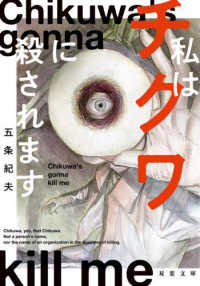- ホーム
- > 洋書
- > ドイツ書
- > Humanities, Arts & Music
- > Linguistics
- > general surveys & lexicons
Full Description
This edited book provides cutting edge contributions from an international array of prominent experts who discuss the relevance of pedagogical stylistics in relation to diverse contexts and areas, including empirical approaches, corpus stylistics, creative writing, literary-linguistic criticism, students as researchers, critical discourse, academic register, text-world pedagogy, cognitive stylistics, classroom discourse, language of literary texts, L1/L2 education, EFL learners, and multimodal stylistics. Intended as a follow-up to Watson and Zyngier (2007), this volume situates the reader by offering a broad assessment of how the field has developed during the past 15 years and where it stands now. By examining both contemporary research and future challenges, it should be regarded as essential reading for all teachers, researchers, scholars, and students interested in understanding language and how to apply stylistics in educational settings. This book will be of interest to students and scholars working in stylistics, cognitive linguistics, language teaching, applied linguistics, literary studies, and materials development.
Contents
Foreword: Professor Peter Verdonk.- Part I: Assessing and broadening the scope of Pedagogical Stylistics.- Chapter 1. Pedagogical stylistics (PS) since 2007. A baker's dozen. (Geoff Hall).- Chapter 2. Corpora in the classroom: teaching style and register variation to Japanese EAP students via pedagogical corpus stylistics. (Marcus Bridle and Dan McIntyre).- Chapter 3. Literary Criticism and Linguistic Criticism: The Case of Ezra Pound's Present Perfect (Violeta Sotirova).- Chapter 4. Devices, Settings and Distractions: A study into how people read Literature. (Esmeralda Bon and Michael Burke).- Part II: Cognitive perspectives.- Chapter 5. Trust the reader. (Peter Stockwell).- Chapter 6. Re-thinking stylistics through Cognitive Grammar: Construal and point of view in the classroom. (Chloe Harrison and Marcello Giovanelli).- Chapter 7. A text-world pedagogy for young stylisticians. (Ian Cushing).- Chapter 8. Text World Theory in the English Classroom (Joanna Gavins and Paul O'Farrell).- Part III: Reader Engagement and Feelings.- Chapter 9. Away from reading - toward oral feelings. Experiments on poetry with students. (Anna Chesnokova and Willie van Peer).- Chapter 10. The challenges of evaluating literary text engagement using pedagogical stylistics with young bilingual learners. (Odette Vassalo).- Chapter 11. Multimodality and reader engagement. (Olivia Fialho and Natalia Igl).- PART IV: Innovations in the Educational Setting.- Chapter 12. Revising Role-Based Literature Circles for EFL Classrooms in Japanese Universities (Paul Sevigny).- Chapter 13. Rhyme and repetition in an EFL classroom in Brazil: An empirical assessment. (Juliana Jandre, Sonia Zyngier and Vander Viana).- Chapter 14. Why do I write this way? - tracking the stylistic development of doctoral writers (Jane Spiro).- Chapter 15. A Study on the Correlation between L1 and L2 Proficiency: A Pedagogical Stylistic Analysis of English Writings by Japanese EFL Learners (Azumi Yoshida and Masayuki Teranishi).- PART V: Afterword.- Looking ahead (Michael Toolan).








